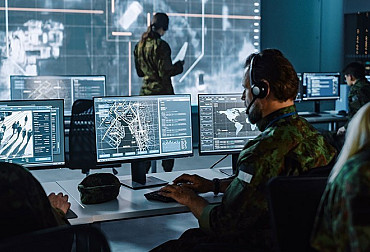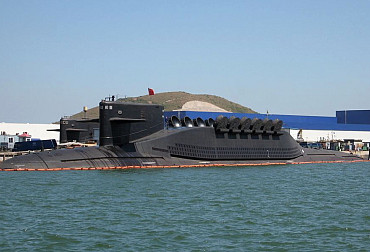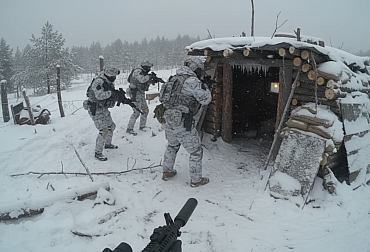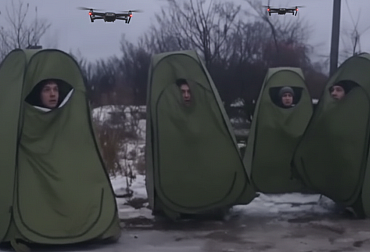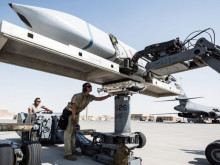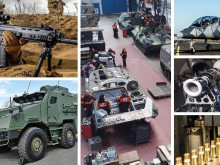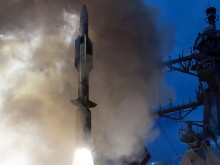Massive and rapid strengthening of defence production capacities can be a trap
We are in a tense situation where the volume and structure of Western arms and ammunition supplies will decide under what acceptable or tragic conditions the path to a ceasefire between Russia as the aggressor and Ukraine as the invaded country will open. This corresponds to the realisation that the capabilities of the European and American defence industries are currently totally inadequate to the demands of the ongoing defence operations of the Ukrainian armed forces. In extreme simplification, we will shoot in a week what we have produced in a year.
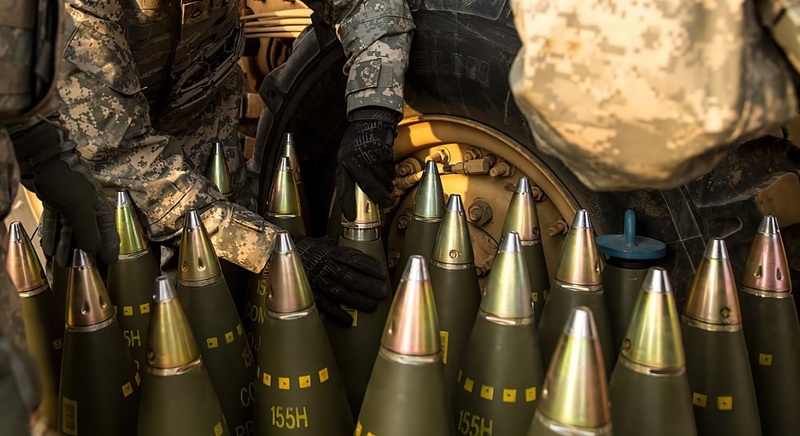 Picture: We are in a tense situation where the volume and structure of Western arms and ammunition supplies will determine under what acceptable or tragic conditions the path to a ceasefire between Russia as the aggressor and Ukraine as the invaded country will open (illustration photo) | U.S. Army
Picture: We are in a tense situation where the volume and structure of Western arms and ammunition supplies will determine under what acceptable or tragic conditions the path to a ceasefire between Russia as the aggressor and Ukraine as the invaded country will open (illustration photo) | U.S. Army
As a simple example, let us take standard artillery ammunition of 155 mm calibre, of which the Ukrainian army consumes, according to its own estimates, up to 5 000 pieces per day. At the beginning of this year, full-running US production provided between 15 and 20 thousand shells per month, according to various records. European significantly less.
There were over 45 thousand Javelin anti-tank guided missiles in allied depots before February 2022, and production was essentially non-existent as a newer, lighter model was undergoing testing. But even so, for the three-year period 2020 to 2022, only 2,037 units had already "rolled off the line." The Ukrainians fired about 300 Javelins in the first week of the war. Thus, stocks began to disappear rapidly and production capacity is not at all ready to resume mass production, as it was simply not foreseen in the foreseeable future.
It should also be remembered that artillery ammunition, anti-aircraft and anti-tank guided missiles are still actually ammunition, i.e. clearly consumables. There has also been a great deal of discussion in recent months about the weapons themselves, even those of medium technological complexity, such as tanks or self-propelled gun howitzers. There the situation is still quite different. The entire production of these systems no longer involves continuous 'belt' production in large batches. Orders for these machines are always spread out over a number of years and often in multiple production "batches" or small series of a few pieces - now ten, now a dozen. It is noteworthy that such small volumes are not the prerogative of smaller armies, but also apply to militarily powerful countries: Great Britain, France, and, in terms of order, the United States. Even more significant and often overlooked is the fact that production is exactly the same in Russia. From publicly available sources, it can be deduced that for many years prior to the outbreak of the war against Ukraine, the volumes of tanks produced in large Russian factories were quite commonly perhaps 30 units per year - and larger numbers were rather the exception. Moreover, only some of the newly delivered machines were brand new, and the Russians also stuck to partial modernisations, upgrades and rebuilds of older tanks.
The reasons have been repeated many times: there was no need. After the end of the Cold War, with the exception of the former Yugoslavia, a high-intensity armed conflict became an extremely unlikely scenario, and military-industrial complexes came under intense pressure to downsize, downsize, and in many countries to disintegrate altogether. Peacekeeping operations of an expeditionary nature required lighter and more mobile equipment, typically wheeled vehicles of various categories of protection and weight. Traditional heavy combat equipment was employed, but rather marginally. In any case, everything was needed incomparably less. At that time, purchases began to be made in small batches, including ammunition, and many Western arms factories were glad to have survived the "peace dividend" at all. Even the successful ones, which developed new types of weapons and supplied them in limited numbers to professional or largely professionalised armies, had to undergo a huge quantitative reduction in their own production capacity. The German Rheinmetall is a conglomerate of various plants with a very broad production portfolio, but none of them is really large and the majority of the sites are small plants with a limited number of employees, where no massive increase in production is out of the question in terms of construction, technology and personnel. In Central and Eastern European countries, the survival of the defence industry has been even more difficult and has followed even more convoluted paths. In Poland, the state has kept several large companies afloat and has also supported their integration into larger units, among which Polska Grupa Zbrojeniowa dominates. In the Czech Republic, the Czechoslovak Group holding company has gradually but surely crystallised and grown, but it is largely building its profile as a modern industrial group that does not need or want to be primarily classified as an 'armaments manufacturer' and is patiently gaining positions in niches from which it is then expanding territorially. So there are not critically few companies in Europe that can produce a tank, an infantry fighting vehicle, a self-propelled howitzer – but over the last many decades they have had to adapt to a limited demand that has ensured sales, but only in low volumes, at relatively high unit prices, and carefully staggered over time to make it worthwhile to keep the factories running, pay engineers and workers, and develop new products. This ecosystem quite logically supported the slowing of generational turnover in military equipment, and fed the trend to also repeatedly modernize and innovate existing, albeit gradually and inevitably obsolete, platforms.
Today, however, we are thrust into a situation that this system was not really built for. We read various statements about 'wake-up calls' and 'cold showers', about the expected permanent and fundamental deterioration of the security situation in Europe, and most often followed by plans to start churning out 155 mm artillery shells as quickly as possible - because yesterday was too late, missiles for HIMARS systems and the launchers themselves, and of course anti-aircraft and anti-tank missiles, which have worked very well, and we end by considering how terribly long the queues for the new Leopard 2 tanks are lengthening, given the speed of production, with Norway newly joining Hungary and the Czech Republic's decision expected.
The only response to this situation at present is a call for a massive increase in production capacity. This has also already started to happen. In the USA, a programme has been launched to multiply the production of 155 mm ammunition to 90 000 units per month, although this target will not be reached for two years. European concerns are already working intensively to increase the production of combat vehicles of various categories in anticipation of new orders.
However, should we not look beyond the horizon of this immediate and short-term clear need? Will this policy be sustainable when the security situation in Eastern Europe changes again? Will the massive investment in the defence industry made in the short term be justified even after the only truly fundamental threat – that is Russia and its revisionist and imperialist ambitions - has been hypothetically reduced or eliminated, for example, by economic depletion, regime change or a shift in the priorities of this actor? What if, in a matter of months, a year or two, there is a lull in the arms race or even a stabilisation of the security situation? In a few years, then, massive production of artillery ammunition will be underway, the lines will be ready to deliver much higher numbers of combat equipment - but by then the war in Ukraine may already look very different, becoming a frozen conflict of minimal intensity with sporadic combat actions, and even its complete end cannot be ruled out.
A hypothetical scenario in which, for whatever reasons, the urgent need to churn out new weapons and ammunition ceases to exist should be part of the broader consideration in the development of defence policy and strategy by NATO, the EU and its member states, as it is not entirely outside the range of possible trajectories.
Should such a situation arise, it is clear that there will remain a need to replenish the stockpiles of European armies in those types and categories of weapons and ammunition that have been depleted in often significant volumes by redeployment to the benefit of the struggling Ukrainian army. In addition, there will remain a demand driven by the need to consolidate and unify the armaments of the Ukrainian army for the next period. But what next, once European armies return to a more moderate pace of their own modernisation? Macroeconomic factors, such as public deficits and shocks caused by the covid, the energy crisis in Europe, inflation, and the halt or slowdown in economic growth, cannot be overlooked. The question is what effect the substantial increase in defence production capacity and the intensification of arms production will have on the debt levels and stability of European states. The needs of their militaries may be saturated relatively soon, or their modernisation ambitions may run into economic limits. However, European manufacturers will be 'revved up' and investment will be made - will we start to encourage exports to the world? Will we look for new customers?
The next phase of this hypothetical development is when governments start to quietly instruct the defence industry that it is time to reduce production capacity again, with all that entails and what Europe has already gone through in the 1990s, for example – but the burden of the massive investments made recently will remain.
The factors by which this trap can be avoided are extremely varied. The first, and also realistically applied, is to cover the current extraordinary need by 'wiping out' stockpiles, going beyond the standard acceptable risk (in the sense of reducing one's own defences) on the donor side. Taking this risk may be a relatively rational choice in this situation, especially when the state in question is already in the process of a qualitatively significant modernisation of its armaments and has secured suppliers.
Another factor is technological progress, which allows a significant substitution between quantity and quality. For example, the current development of reconnaissance, tracking and target acquisition combined with precision-guided munitions allows for a substantial reduction in the tabular requirements for artillery fire tasks. A single, albeit much more expensive, modern round can accomplish a task for which our army until recently calculated 24, 48 and, under degraded conditions, perhaps 96 rounds.
On the side of the providers of production capacities, i.e. defence industry companies, diversification of the production portfolio is a very desirable strategy. And not only between the different types of armaments for ground and air forces, but preferably also between civilian and military production, crossing over into different industrial sectors. This practice has long been successfully implemented in our country by the already mentioned Czechoslovak Group, and in Germany by Rheinmetall, for example. The truly large global manufacturers, of course, manage the variability of demand and its waves by default, both thanks to the distribution of production sites and thanks to their partial ability to manage and influence demand.
The point of this reflection is not to question the determination to eliminate the defence deficits of European countries, and certainly not to question the will to provide massive military aid to Ukraine as quickly as possible. However, it is worth thinking systematically about how to implement these steps in such a way that they do not subsequently result in damage to private capital that would ultimately have to be compensated for from public budgets, because the motivation for investors came from a clear political mandate. However, the aim should certainly be not to expose the economies of NATO and EU members to further avoidable shocks.
PhDr. Libor Stejskal, Ph.D.
Security Analyst at the Prague Security Conference, z.s. He has long been working on security policy, its social, economic and environmental aspects, population protection and issues of vulnerability and resilience. He has been working on trends in the modernisation and use of armed forces and the security implications of climate change, and in 2011 he contributed to the White Paper on the Defence of the Czech Republic. In 2008-2009 he worked in the civilian part of the Provincial Reconstruction Team in Logar Province, Afghanistan. He has worked on the history of the Czechoslovak army in the 1930s and is co-author of a book on 1938 in northern Bohemia. Currently, among other things, he conducts training courses in the field of crisis management.











